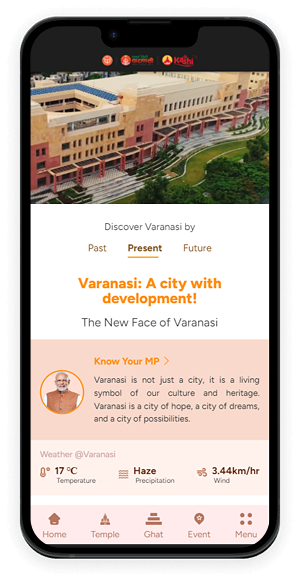काशी- भारत का एक लघु रूप
काशी- भारत का एक लघु रूप के बारे में
काशी में आप जहाँ भी जाएँ, पूरा भारत आपके पीछे-पीछे चलता है।
यह पदयात्रा वाराणसी के घाटों से बाहर निकले बिना पूरे भारत की यात्रा है। तमिल शैवों के द्रविड़ मंदिरों से लेकर बंगाल के टेराकोटा मंदिरों तक, मराठा-कालीन महलों से लेकर नेपाली पगोडा मंदिरों तक, काशी का हर कोना उपमहाद्वीप के एक अलग हिस्से की सांस्कृतिक, आध्यात्मिक और स्थापत्य कला की छाप समेटे हुए है।
आप प्राचीन नदी किनारे स्थित महलों, मंदिरों और मठों से गुज़रेंगे जो दूर-दूर के क्षेत्रों के लिए दूतावासों के रूप में काम करते थे, उन राजाओं, संतों और विद्वानों की कहानियाँ सुनेंगे जो काशी आए और कभी वापस नहीं गए, और यह भी जानेंगे कि बनारस को अक्सर "लघु भारत" क्यों कहा जाता है, जो गंगा के तट पर बसा भारत का एक जीवंत सूक्ष्म जगत है।
- अनुशंसित समय: सुबह (सुबह 6:00 बजे से 10:30 बजे तक)
- अवधि: 3.5 घंटे
- प्रारंभिक बिंदु: शिवाला घाट
- अंतिम बिंदु: गोपाल मंदिर
- यात्रा का तरीका: पैदल
- इतिहास प्रेमियों, सांस्कृतिक यात्रियों, फ़ोटोग्राफ़रों और विरासत प्रेमियों के लिए उपयुक्त
यात्रा कार्यक्रम
कृपया ध्यान दें: यह यात्रा कार्यक्रम इस यात्रा का एक मोटा खाका है। पर्यावरण के प्रति संवेदनशील स्थानों पर भीड़भाड़ से बचने के लिए हम अपना पूरा यात्रा कार्यक्रम ऑनलाइन प्रकाशित नहीं करते हैं। प्रत्येक अनुभव आपकी विशिष्ट आवश्यकताओं के अनुसार हाथ से तैयार और अनुकूलित किया गया है।
प्रत्येक अनुभव को हाथ से तैयार किया गया है और आपकी विशिष्ट आवश्यकताओं को पूरा करने के लिए तैयार किया गया है।
key_highlights
Our walk begins at Shivala Ghat, a southern gateway to Kashi, historically home to monasteries and scholar residences from Tamil Nadu and Andhra Pradesh. Here, Ganga-facing libraries once housed rare palm-leaf manuscripts, and mathas served as hostels for southern scholars who came to study in the sacred city. You’ll hear how Andhra academicians shaped Banaras’s intellectual life and how this ghat became a meeting place for southern and northern traditions.
Built under the patronage of Vijayanagara rulers, this ghat’s architecture blends Dravidian temple elements with Banarasi craftsmanship. We explore Andhra Pradesh’s pilgrim routes to Kashi, the role of southern monarchs in funding temple rituals here, and the continuing presence of Andhra priests who serve in local shrines.
Once a royal rest house for Karnataka’s visiting kings and pilgrims, this ghat preserves palace-style Dravidian architecture in the heart of Banaras. The nearby Chakra Lingeshwara Temple stands as a spiritual link to Karnataka’s Shaivite traditions, brought north by wandering monks centuries ago.
This temple’s towering gopuram, uncommon in the north, marks the presence of South Indian Shakti worship in Banaras. Known for hosting philosophical debates and preserving sacred geometry traditions, it shows how Sri Vidya and Tantric practices traveled from southern India and adapted to Kashi’s religious environment.
Dedicated to Lord Kedarnath, this temple is run by Tamil-speaking priests and is considered one of Kashi’s 12 Jyotirlinga satellites - spiritual outposts linking Uttarakhand’s Kedarnath to Tamil Nadu’s devotion. The adjoining Sri Kumaraswami Mutt has been a center for Tamil Shaivism for centuries, maintaining southern-style rituals to this day.
A beautiful example of Bengali terracotta artistry, this temple is dedicated to the tantric goddess Tara. It was built under the patronage of Rani Bhawani of Natore, whose philanthropy brought many Bengali scholars and artists to Kashi. We’ll discuss how Bengal’s intellectual and spiritual elite shaped Banaras’s cultural landscape.
A humble yet historic residence where Lahiri Mahashay taught Kriya Yoga - a discipline that would later spread across the world through Paramhansa Yogananda. Standing here, you’ll hear how a quiet spiritual revival in 19th-century Banaras gave rise to a movement that touched seekers on every continent.
Set apart by its intricate carved woodwork and tiered pagoda roof, the Nepali Temple is a faithful replica of Kathmandu’s Pashupatinath Mandir. Commissioned by the King of Nepal, it reflects the centuries-old bond between the Himalayan kingdom and Kashi, a relationship rooted in shared devotion and pilgrimage.
Here stand the estates of the Rewa royals from Madhya Pradesh, who maintained rest houses for pilgrims and generously funded festivals in Banaras. Their ghat tells stories of Baghelkhand’s deep ties to Kashi, especially during the great religious fairs.
This elegant palace with Rajasthani arches and Gujarati-inspired balconies belonged to western Indian patrons who made Kashi their commercial and spiritual base. We explore how merchants from Kathiawar, Kutch, and Marwar brought wealth, festivals, and architectural flair to the city.
Seat of the Digpatiya Raj family from Bengal–Bihar, this palace preserves Maithili cultural traditions and is especially active during Chhath Puja. It’s a reminder that Bihari communities have been among Banaras’s most steadfast devotees.
At this legendary confluence of five rivers and traditions, the Bindu Madhav Temple stands as a witness to centuries of philosophical exchange. Here, Vedantic scholars, Bhakti poets, Vaishnava devotees, Shaiva ascetics, and Shakta practitioners shared the same sacred space.
A 17th-century temple with a rare blend of Rajput and Maratha features — from chhatris to gopurams. Built during the Maratha restoration of Kashi’s temples after Aurangzeb’s destruction, it stands as a monument to revival and resilience.
Our walk concludes at a temple linked to the Jain and Gujarati merchant community. Traders who settled here made Kashi their karmabhoomi, funding not only temples but also educational institutions and pilgrim services that shaped the city’s life.



